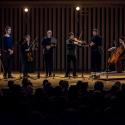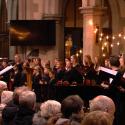Anyone who came to the National Youth Orchestra’s annual Prom in the hope of hearing some roof-raising feelgood blockbuster might have slunk out disappointed into the tropical night of Kensington. What an ambitious, high-concept menu Sir George Benjamin slated for the teenaged regiment – over 160 of them at full strength – and how confidently they served (almost) all of it. If this was big-band music, then it took the form of a suite of pieces that often demanded that the orchestra march – or perhaps, swim – in several directions at once.
The sole nod to a populist past came at the outset, when Benjamin opted for the Rimsky 1886 re-engineering of Mussorgsky’s A Night on the Bare Mountain rather than the rougher, more revolutionary versions the maverick composer had made in the previous decades. Three musicians from the NYO (why first names only though?) introduced the pieces, and in this case made the obligatory nod to the work’s role in Disney’s cartoon concert Fantasia. Benjamin’s rendering of this scary-comic witches’ sabbath, with its wide dynamic range and deft applications both of the brake and accelerator, recaptured that buzz of childhood excitement. The woodwind solos struck some deliciously plaintive notes. Meanwhile, the hefty glamour of the brass, and tense, driving strings, niftily turned up the dial of supernatural thrills.
Sheer impact does matter with the NYO, but so does filigree subtlety
After this danse macabre, Benjamin’s own Dance Figures from 2004 lowered the temperature – but not the level of commitment from the orchestra. First scored as ballet music, these nine “figures” interpret the dance fairly obliquely as they build into an ever-shifting mosaic of textures and rhythms in which many instruments – not least the formidable platoon of the NYO percussion – have some clever, heavy lifting to do. The raucous, bluesy brass shone in “Hammers”, as did the more serene viola flight in “Song”. Benjamin’s approach gave this vast array of players no safety in numbers; his roving sonic spotlight insists on high achievement everywhere, and secured it.
The low brass and strings that grumble intermittently in Dance Figures carried over into a sort of ominous whisper at the start of Ravel’s Piano Concerto for the Left Hand. Written for the pianist Paul Wittgenstein (brother of philosopher Ludwig), who had lost his right arm in the First World War, Ravel’s commission called for the composer to transform the piece’s necessary bias towards the lower reaches of the piano’s range into a dark-textured virtue. Does the brooding, rumbling menace of the orchestral writing not only match the sombre colours of the piano, but call back some buried memory of a distantly heard battle? In any case, pianist Tamara Stefanovich (pictured below) relished the sombre colourings, even if it occasionally felt as if she and the NYO had parted company. The jazzy, skipping march of the central scherzo had a manic pulse that brings little relief, and the orchestra maintained its fine dark edge (special mention for the keening bassoon). Oddly overshadowed at moments in the concerto, Stefanovich encored sublimely with the late Oliver Knussen’s “Prayer Bell Sketch”. It both served as a poignant elegy, and reminded us of how much Debussy’s quicksilver spirit hovers over this year’s Proms. 
In Debussy’s La Mer, Benjamin again eschewed any broad-brush, wall-of-sound dramatics in favour of clear articulation that let us listen to every ripple and eddy of this inexhaustible symphonic poem. If the NYO boat sounded a little hesitant as it pushed off, soon enough the woodwind (excellent all evening) steadied the ship and prepared us for those rolling waves of brass. Impressively, Benjamin summoned both power and precision from his young crew. When the music fragments and disperses, like an image in the water shattered by a stone, we could hear every facet as it split. And the heart-swelling tuttis invited us to ride the surf of sound rather than drown in it. Yes, sheer impact does matter with the NYO, but so does filigree subtlety. Benjamin delivered both.
- Listen on the BBC iPlayer for the next 28 days to Prom 28 here
- Read more classical music reviews on theartsdesk













